From 2002 through 2007, the Japanese economy staged a recovery, driven by strong external demand. However, following the outbreak of the global economic crisis in September 2008, external demand - the main engine of the economy - dropped dramatically or "evaporated" as some people describe it. And unless this evaporated external demand is restored or Japan finds a way to make up for it with domestic demand, the Japanese economy will be unable to get back on the path to recovery.
In what follows, I would like to provide an overview of anticipated future trends for both external and domestic demand, and consider issues that should be addressed in formulating external economic policies from the viewpoint of achieving an economic recovery.
I. End to an external demand-led recovery
As a prelude to the main theme, allow me to look back on the development of the Japanese economy since the turn of the century.
Although it may have long been forgotten, from January 2002 through October 2007, Japan experienced its longest period of economic growth in the postwar period. In a nutshell, it was an "external demand-driven" recovery. The Ministry of Economy, Trade and Industry (2009a) provides a comparison between the latest recovery and previous recoveries since the mid-1980s with respect to the movements of the value of nominal gross domestic product (GDP) by component of demand ( figure 1 ). It shows that exports grew at the fastest pace in the latest recovery that began in 2002. During that period of time, Japan's exports continue to expand against the backdrop of a weak yen resulting from low interest rates, setting a new record every year from 2004 to 2007. The ratio of exports to GDP also marked the record high of 17.1% in 2007. Meanwhile, within domestic demand, private-sector capital investments marked a degree of expansion but this was largely attributable to the increased exports. *1 Growth in private consumption, a demand component that has the largest weight in GDP, was kept to minimum.
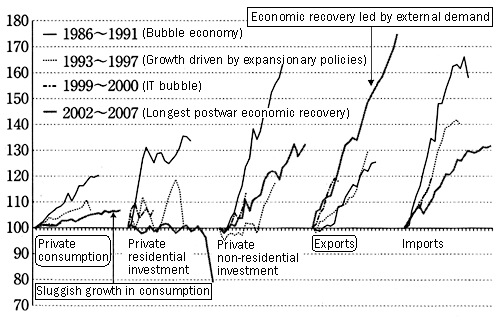
Note 1: Indexed with the value for the first quarter of each recoveryperiod as 100.
Note 2: Based on data from the National Accounts of Japan, Cabinet Ofice.
Source: White Paper on International Economy and Trade 2009, METI (209a)
Supporting the external demand-led recovery in Japan were the U.S. and European countries, where the economies were continuing to perform strongly, and emerging Asian economies - particularly China - that experienced high economic growth primarily through increasing exports to the U.S. and Europe. The Ministry of Finance's trade statistics show that exports to the U.S., the European Union, and Asia respectively accounted for 20.1%, 14.1%, and 48.1% of the total value of exports in 2007, the year in which Japan's exports hit record high. That is, these destinations together accounted for more than 80% of Japan's exports. More recently, the export of parts intermediate goods - such as parts and components - to Asia increased sharply and the so-called "triangular trade," a pattern of trade in which intermediate goods exported from Japan to other Asian countries are processed into final goods for exports to the U.S. and Europe, expanded ( figure 2 ). *2, *3
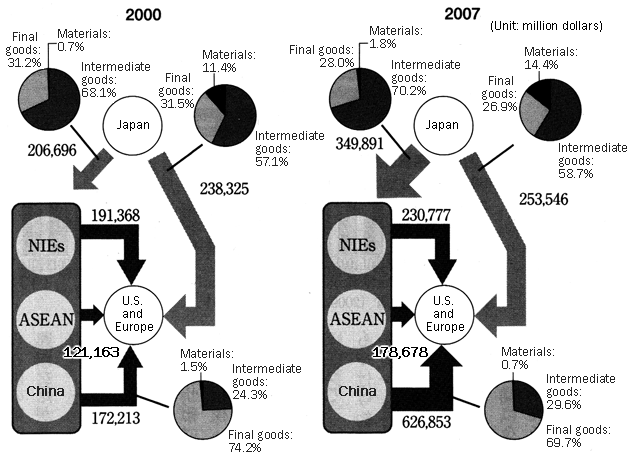
Note: Created based on data from the RIETI-TID database.
Source: White Paper on International Economy and Trade 2009, METI (209a)
Japan's recovery driven by robust external demand began to show signs of decline in summer 2007 with the surfacing of problems with subprime mortgage loans in the U.S. Japan's exports to the U.S. took a downward turn in September 2007 and the nation's economy began to recede in November 2007. In the subsequent months, Japan's exports to Europe and Asia continued to expand but the pace of growth gradually decreased. And then came September 15, 2008.
Following the outbreak of the global economic crisis, Japan's exports to all destinations dropped rapidly and sharply. Japan's exports in December 2008 plunged 35.0% year on year and the rate of decrease exceeded that level for each month in the subsequent eight months.
Japan's real GDP, which is reliant on external demand, registered annualized negative growth of 12.8% for the fourth quarter of 2008 and 12.4% for the first quarter of 2009, recording the worst growth figures since 1980 which also represented the worst performance among developed economies.
Japan's exports in the first half of 2009 totaled about 24 trillion yen, falling by 42.7% from about 41.9 trillion yen for the corresponding six-month period in 2008. The amount of decrease, 17.9 trillion yen, is equivalent to approximately 3.5% of Japan's nominal GDP for 2008 amounting to 508 trillion yen. Simply considered, this suggests that without reviving that much demand, the Japanese economy would not be able to return to its pre-crisis level.
But would it be possible to revive demand on such a large scale?
II. Prospect for reviving evaporated external demand
First, let's consider the possibility of recovering evaporated external demand to the previous level.
(1) U.S. economy
The U.S. is the world's largest economic power and, as a single country, it is the largest destination for Japan's exports.
*4
The future course of the Japanese economy relies significantly on the recovery of the U.S. economy.
Unfortunately, however, prospects for the U.S. economy are far from promising.
A recovery in consumption, which accounts for 70% of total demand in the U.S., is not yet in sight. U.S. consumption is characteristically wealth-driven. At the moment, however, the wealth effect is negative due to sharp falls in housing prices. A significant deterioration in the employment situation is adding downward pressure on consumption. Meanwhile, against the background of declining family income and other factors, the loan delinquency ratio is on the rise, which translates into additions to bad assets on banks' balance sheets and an increase in the number of bank failures. *5 In March 2009, the U.S. government announced a scheme designed to remove bad assets from banks' balance sheets. But many observers, including Kobayashi (2009), question the efficacy of the scheme. Indeed, in Japan as well as in Sweden, which also experienced a real estate bubble collapse in the early 1990s, it was only after public funds had been injected into banks to help them clean up their balance sheets that an end to their bad loan problems came into sight ( figure 3 ). It is expected that there will be some twists and turns before the U.S. resolves its bad loan problems.
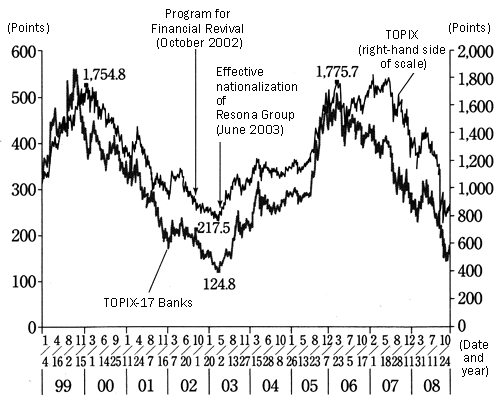
Note: Created based on data provided by Bloomberg.
Source: White Paper on International Economy and Trade 2009, METI (209a)
Moreover, when the U.S. finally paves the way to solve the bad loan problem, recovering therefrom would take a long period of time. Even in Sweden, which has been acclaimed for successfully solving its bad loan woes, it took seven years for real estate prices to return to their 1991 pre-bubble peak levels. *6 Judging from measures and steps taken to date, the U.S. needs to prepare itself for a long-term battle. To be sure, the U.S. has a large number of competitive companies, which are considered exceptional even by global standards, and she is also on the cutting edge of science and technology. It thus goes without saying that the U.S. economy is fundamentally strong and its presence in the global economy remains magnificent. Yet, it is hard to imagine that the U.S. will resume its role as the engine of the world economy through overspending, at least for some time.
(2) European economy
The size of the market in Europe is comparable to the North American (the U.S. and Canada) market. In 2007, the nominal GDP of the combined 27 EU member countries amounted to 16.9 trillion dollars, exceeding the 15.2 trillion dollars of North America. Key to setting the future course of the European economy are Germany, the United Kingdom, France, Italy, and Spain, which together account for more than 70 percent of European GDP. Of these five countries, Germany, the largest economy within the EU accounting for 19.6% of the combined nominal GDP, is heavily reliant on exports with the dependency ratio at 46.7% in 2007. And just like Japan, Germany has been suffering from a severe decline in exports. The German economy posted significant negative growth of 9.4% in the fourth quarter of 2008 and 13.4% in the first quarter of 2009. Meanwhile, the sharp decline in real estate prices in the UK and Spain is causing a severe impact just as it has done in the U.S. And Italy and France are no exception in being hit by recession. So, it is reasonable to assume that it will take a considerable period of time for the European economy to make a comeback.
(3) Emerging economies
As opposed to developed countries, emerging Asian economies - most notably, China and India - have been able to maintain high growth.
China's real GDP growth rate for 2008 was 9.0%, dipping below 10% for the first time in six years. On a year-on-year basis, China's real GDP grew 6.1% in the first quarter of 2009 and 7.9% in the subsequent three-month period, by far outpacing growth in other economies and showing a clear recovery trend.
Like some other economies, China is fairly dependent on exports. But the level of per capita income remains low, meaning that China has huge potential consumption demand. Because of this, domestic demand - i.e. consumption and capital investments - has continued to expand steadily even after the outbreak of the global economic crisis, thereby alleviating the impact of reduced exports.
Apart from China, India and Indonesia have shown relatively robust economic performance. India posted fairly strong year-on-year growth of 5.8% both in the fourth quarter in 2008 and the first quarter of 2009. Likewise, Indonesia has been maintaining growth at the 4% level since the outbreak of the crisis, at least, through the second quarter of 2009. Both countries are characterized by a large population, a low level of income per capita, huge potential consumption demand, and relatively low dependence on external demand. These characteristics worked to mitigate the impact of the crisis.
Given these observations on the post-crisis trends in economies around the world, it is highly probable that emerging economies will be the only ones capable of achieving steady economic growth in the foreseeable future.
At the same time, however, it is true that there remain huge gaps between emerging and developed economies in terms of economic size. For instance, take a look at the 19 countries that participated in the London Summit in April 2009, that is, Group of Twenty (G20) economies excluding the EU. Measured in nominal GDP, the combined economic size of eight advanced countries (G7 + Australia) was more than twice as big as that of the remaining 11 countries, i.e. emerging economies, in 2008 and, based on figures forecast by the International Monetary Fund (IMF), the ratio between advanced and emerging nations remain approximately two to one in 2014 ( figure 4 ).
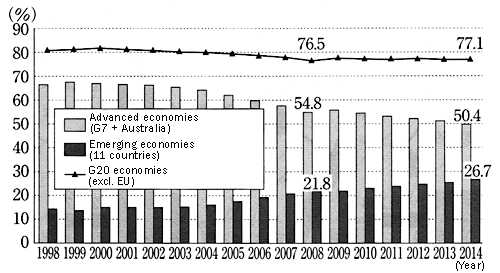
Note: Created based on data from the IMF World Economic Outlook Aprl 2009.
Source: White Paper on International Economy and Trade 2009, METI (209a)
Compared in terms of per capita income level, the gap between advanced and emerging countries is even greater. Although it is just a matter of time for China to exceed Japan to become the world's second largest economy in nominal GDP, Japan's per capita GDP was about 13 times that of China in 2007. *7 And it is not easy for companies from advanced economies to enter emerging economy markets where people's income levels are far below those in their home countries. Thus, we should realize that it is unrealistic to expect emerging economies to make up for "evaporated" external demand.
Considering all the above, chances are extremely low for the recovery of "evaporated" external demand at least for the time being, setting aside any possibilities in the more remote future.
III. Prospect for domestic demand expansion
This would prompt us to turn to domestic demand to make up for a decrease in external demand. But again, we cannot pin too much hope on this scenario given the fact that Japan's domestic demand failed to surge even in the longest postwar economic boom.
As shown in ( figure 1 ), private consumption remained sluggish in the latest recovery.
Declines in income levels are a major direct factor behind the sluggish private consumption. As a general rule, income levels improve while the economy is in recovery mode. However this was not the case in the latest recovery in Japan, during which income levels generally declined. According to the Ministry of Health, Labour and Welfare's Basic Survey on Wage Structure, the average monthly wage for "regular employees" (including both men and women) decreased from 305,800 yen in 2001 to 301,100 in 2007. Such a phenomenon was not observed either in the bubble period of the late 1980s or in the recovery in the 1990s.
On the other hand, Japanese companies achieved a steady increase both in sales and ordinary profits. According to the Ministry of Finance's Financial Statements Statistics of Corporations by Industry, sales and ordinary profits for Japanese companies in all industries (excluding finance and insurance) rose 19.1% and 72.5% respectively between fiscal 2002 (April 2002 - March 2003) and fiscal 2007.
These observations imply that the way in which Japanese companies allocate their profits changed significantly over the years. This is in no small way attributable to the globalization of the economy. With emerging economies increasingly integrated into the world economy, competition intensified on a global scale, prompting Japanese businesses and industries to focus more on international competition. Thus, while making more investments in competitiveness and enhancing returns to shareholders, they have been compelled to hold down personnel and other costs, altogether resulting in significant changes in profit allocations. *8
So, although declining income has been a direct cause of sluggish domestic demand, it should be noted that this has occurred against the backdrop of globalization and its impact on Japanese businesses and industries. Therefore, a robust recovery in domestic demand is unlikely unless Japanese industries take appropriate steps to cope with globalization.
IV. External economic policy issues that need to be addressed to ensure growth
As discussed above, we have yet to see signs heralding a full-fledged recovery in demand - whether foreign or domestic - to a level prior to the crisis. In this situation, it is crucial for the government to proactively seek opportunities to create and capture demand. In doing so, the government needs to have a clear picture time trends. Following the outbreak of the global crisis, some countries have taken protectionist trade measures, but there is no stopping the globalization of the economy. Rather, globalization is set to further deepen as emerging economies grow in the coming years. Given this current of time, Japan should make a more conscious effort to use the ongoing trend of economic globalization to its advantage.
From this viewpoint, the following initiatives are important in the area of external economic policies
(1) Supporting private-sector initiatives to explore emerging markets
Emerging economies, though not sufficient to make up for "evaporated" external demand, will be where the world's greatest growth potential lies at least for the time being. Particularly, given the accelerated growth of the middle income class (volume zone) population in emerging economies in recent years,
*9
it is economically rational for companies to move into these emerging markets.
In cases where a Japanese company attempts to advance into an emerging market, the company typically takes over or forms an alliance with a local company. This is partly because having a physical presence in the local market is instrumental in capturing the characteristics of demand in the market. At the same time, it is inevitability because, given the income levels of general consumers in emerging economies, products made in and imported form a developed country would be no match for their locally produced counterparts in price competition.
It is expected that more and more companies - not only manufacturers but also companies in various non-manufacturing sectors - will move to launch local operations in emerging economies. Meanwhile, as a result of economic growth, these countries are now confronted with a host of problems such as insufficient social infrastructure, energy shortages, and environmental pollution. In this regard, Japan's infrastructure-related industries - power, railroad, water supply, and so forth - have excellent technologies as they have tackled similar problems for years. However, as domestic demand for such infrastructure is almost saturated with the maturing of the economy, they are now facing an increasing need to expand into overseas markets.
Considering these situations, it is all the more important for the Japanese government to promote policies conducive to private-sector efforts to capture volume-zone consumers in emerging economies by such means as lowering costs and implementing effective marketing. As specific policies that will be of increasing importance in the coming years, Japan should seek to: improve the investment environment in emerging economies by concluding economic partnership agreements (EPAs), bilateral investment agreements, tax agreements, and so forth; ensure the protection of intellectual property rights in emerging economies; and facilitate the training and nurturing of foreign nationals conducive to business activities of Japanese companies that have launched operations in emerging economies.
(2) Leveraging overseas growth vitality to rekindle the Japanese economy
However, as gradually became apparent through recent studies of international trade, only a handful of highly-productive, large-scale companies will be able to make their ways into emerging markets, even with government support to facilitate such moves.
*10
The remaining majority - i.e. business and industries with relatively low productivity - will have to continue to operate only within Japan. Yet, even those domestic players can benefit from the growth of emerging economies.
For instance, in the area of tourism, robust economic growth in emerging economies has been a key driver in increasing the number of international travelers around the world in recent years. *11 In 2008, the number of outbound travelers from China totaled 45.84 million, *12 nearly three times as large as the 15.99 million from Japan. Attracting these Chinese tourists to Japan will bring significant business opportunities to various domestic businesses.
Similar effects can be expected from the successful attraction of emerging economy enterprises to launch operations in Japan. The growth of emerging economies will prompt more and more companies in these countries to expand their business beyond their national borders. By inviting these companies to Japan, we can expect that the presence of these companies, through their higher productivity, will give a boost to the Japanese economy. *13
The government has already implemented various measures to attract more tourists from abroad as well as to draw foreign direct investments and these efforts have produced some tangible results. But a comparison with other countries suggests that more can be done. *14 Japan must not miss out on golden opportunities presented by the growth of emerging economies but fully exploit them to its advantage. To that end, the government must be prepared to tackle some hard issues that have long been identified but left unaddressed ( figure 5 ).
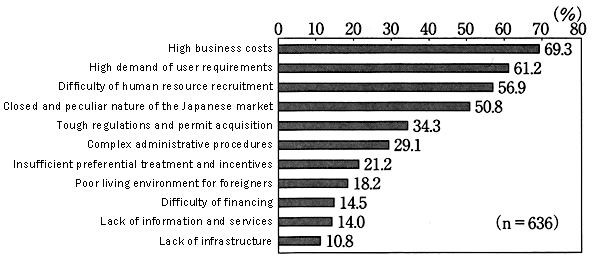
Source: Heisei 20-nendo Tainichi Chokusetsu Toshi ni kansuru Gaishikei Kigyou no Ishiki-chosa Hokokusho [Report on FY 2008 Survey of Affiliates of Foreign Companies on Direct Investment in Japan], (METI 2009b)
(3) Shifting to an industrial structure suitable for global competition
(This issue, though it may appear to be outside the realm of "external economic policy," nevertheless constitutes an element of such policy when it is broadly defined as measures to cope with globalization.)
As discussed in Section Ⅲ, we can generally say that Japanese businesses and industries have been unable to sufficiently adapt to global competition and this remains a major obstacle to expanding domestic demand. Thus, it is imperative for Japan to transform its industrial structure into one that is suitable for global competition.
Global competition is expected to further intensify in the coming years, both between companies and between industries, as those in emerging economies are fast catching up.
Emerging economies are gradually building up competitiveness in capital-intensive industries, adding to their strength in labor-intensive industries. For instance, China's exports to Japan, which used to be predominantly light industry products such as textiles, are now gradually shifting to general and electrical machinery and equipment.
In the face of intensifying global competition, it would be ideal if Japanese companies could stay beyond the reach of those catching up from behind by improving their productivity through research and development (R&D) or by other means. *15 But the catch-up is steadily taking place and given this reality, we should say that the time has come for Japan to seriously consider a full-fledged shift from industries that are labor-intensive and thus eroded by competitors from emerging economies to those that are more capital-intensive or have high growth potential.
Matured markets such as Japan are not necessarily devoid of industries with high growth potential. In the United States, employment has rapidly expanded in the field and welfare services with more jobs are expected to be on the way. *16 This is an area in which Japan can expect to see high growth, with its population aging more rapidly than that of the U.S. Also offering high growth potential are environment-related fields because of the need to address climate change problems.
Intrinsically, shifting from a low growth industry to a high growth industry is a challenge that must be tackled by individual companies by their own will and initiative. In Japan, however, the institutional design of various systems in these industries is subject to significant government involvement. In such a case, companies' decision-making on the change of the main line of business is greatly affected by how the government designs the relevant institutional systems.
What is required of the government is to present, through the design of institutional systems, a clear vision for the development of these potentially high-growth industries. By the way, the "development" of an industry, as referred to here, must be one that is accompanied by a rise in income for those working in that particular industry (because otherwise it would not lead to the growth of the Japanese economy).
Furthermore, if we can successfully convey this vision to people outside Japan, many of them would come to see the potential for dynamic changes and growth in the Japanese economy, which in return would help enhance the mobility of people to and from Japan and expand foreign direct investment in Japan.
V. Conclusion: Turning a crisis into an opportunity
In reality, each of the above-proposed measures can be achieved only with great difficulty. But a crisis can be defined as a golden opportunity to fundamentally review and change conventional measures and systems. In fact, history is filled with examples of success achieved by taking advantage of a crisis. Take a look at the postwar history of the Japanese economy. Each time when faced with crisis, Japan overcame and emerged stronger with both the government and affected industries drastically changing their conventional policies and strategies, as seen in the postwar reconstruction and responses to two oil shocks in the 1970s. On the other hand, Japan was slow to respond when the economy failed to respond in a timely manner when the nation's economy drifted into its long-term doldrums in the early 1990s, which is now referred to as the "lost decade." The pace of the slowdown was so moderate that no drastic steps were taken until the situation turned into a crisis in the late 1990s. Ever since, Japan has been busy continually fixing problems associated with that crisis, which has prevented the nation's economy from achieving a full-scale, strong recovery. In the latest global economic crisis, Japan suffered a significant loss of demand. However, if we can take this opportunity to fundamentally review and redesign the Japanese economy, the crisis may turn out to be a golden opportunity for Japan to put an end to the stagnation?No,, we must definitely make it happen.
* Translated by RIETI from the original Japanese article published in the vol.53, No.10 issue of Sekai Keizai Hyoron from Association for World Economic Studies (AWES).
November-December 2009 Sekai Keizai Hyoron


